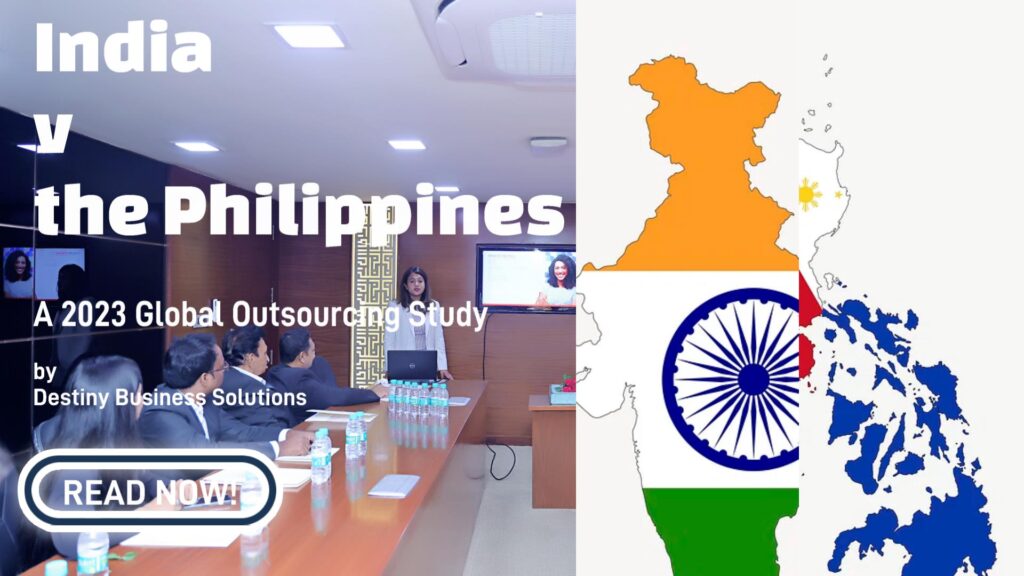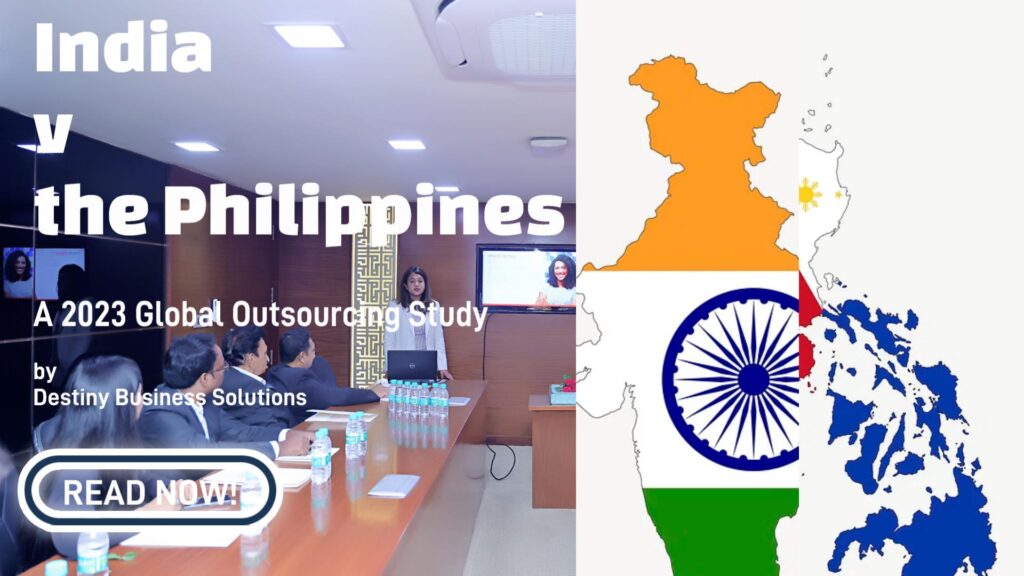
Listen to our India v Philippines in Outsourcing Blog on Audio Right Here!
The rise of IT systems worldwide has ushered in a new era of business in 2023. We now see greater connectivity across continents, leading to higher business volume and interdependence. This is thanks to cloud computing, cybersecurity AI, and automation leading innovation.
While digital transformation drives business volume upward, phygital IT standards must catch up. A slight misalignment in business performance standards can lead to a drastic difference in customer experience. So, choosing the right team and, more importantly, the right market for your business needs demands looking at several factors.
In short, you must know how to outsource your IT department to remote hybrid teams.
Here is a comprehensive guide for how you should choose outsourcing destinations with a reliable partner:
3 Major Outsourcing Destination Differences between India and the Philippines in 2023
Destinations Matter
The first and most important element in selecting your IT outsourcing partner is your destination of choice. India and the Philippines are easily among the top two destinations for finding professional IT outsourcing businesses. Both destinations are well-known for offering a wide range of brands and options for IT outsourcing. However, certain differences decide the quality and service standard you can get for your money.
Primetime for India’s BPO Industry
A 2021 report by London-based data analytics and consulting GlobalData made some promising revelations for the Indian BPO industry, which is expected to reach US$225-250 billion by 2025. It also mentioned that “The combined spending from micro (1-50 employees) and small and medium enterprises (51-1,000 employees) will increase at a CAGR of 5.8 percent over the forecast period until 2025.”
A Business Standard report also mentioned several crucial factors contributing to the growth of the Indian BPO industry. These included the liberalization of voice-based BPO guidelines by government bodies. This has been a major boost for BPOs in India since employees now find it much easier to work from home. The direct impact is more business volume processing and higher service performance standards for domestic and international businesses.
Short Headwinds for Philippine BPOs
In comparison, the Philippine BPO industry is currently experiencing a mixed performance time because of COVID-19-related headwinds. The Business Process Association of the Philippines (IBPAP) forecasted said that “short to medium-term headwinds are anticipated for the (BPO) industry.” However, the long-term projections for BPO real estate leases remain strong. This indicates that the Philippine BPO industry will continue to grow steadily despite the short-term slump.
Since the global BPO industry is highly competitive, the Indian BPO sector might outpace the Philippines in the short term. However, Philippine BPOs are countering slumps and physical office space lease costs using smart team management and hybrid working models. In contrast, India’s micro to SME BPO segment will grow and produce the majority share of revenue for the industry. This may be why India will soon become the top outsourcing destination for small businesses.
When Infrastructure Meets Process
One of the biggest challenges in IT outsourcing is to match infrastructure with international clients. This is important to delivering high-quality customer support and related IT services. When choosing an IT outsourcing partner, businesses must consider their physical infrastructure. This includes the performance of existing IT systems, backup processes, and projected upgrade paths. The combined picture of all these factors will enable businesses to find reliable IT outsourcing partners for the longer term.
How India Supports Its BPO Sector
The Indian government has stepped up its efforts to regulate and organize the Indian BPO industry over the past decade. It has consistently delivered regulatory standards encouraging international businesses to outsource IT in India. In November 2016, the Indian Standards Organization published the International Standard- ISO/IEC 30105, ushering in an “improvement standard that enables risk determination and improvement for service providers performing outsourced business processes. (This) Also serves as a process reference model for service providers.” Similarly, the Indian BPO Promotion Scheme (IBPS) under the current Indian Prime Minister, Sh Narendra Modi’s Digital India Programme focuses on BPO-centric skill-based job creation. This enables Indian BPOs to make further inroads into the international market and make game-changing plays.
Further, Ralf Ellspermann, CEO of PITON-Global and a renowned expert on CX outsourcing to India and the Philippines, weighed in on the Indian BPO industry. In an article published in The Week, he said, “India has consistently led the charge in the global BPO landscape, and this latest wave of technological innovation is a testament to the country’s commitment to excellence. The rapid adoption of AI, ML, RPA, and other advanced technologies is redefining the customer support paradigm and setting new benchmarks for the industry.”
How the Philippines Supports Its BPO Sector
With widely influential policy reforms, the Philippines has been cashing in on its stellar IT growth. One of the most important ones is the enactment of Republic Act No 1165 or the “Telecommuting Act” in 2018—the nation’s BPO industry. In particular, its fiscal and non-fiscal incentivization policies have made business easy for BPOs and spurred rapid growth. A major drawback is that businesses must operate within PEZA geo-limits to get the incentive benefits. They must also procure 70% of their revenue from foreign clients. This created a very tense situation for the Philippine BPO industry when the pandemic hit.
Earlier, PEZA imposed certain restrictions on IT-BPOs within its ambit, like a mandatory Letter of Authority. This is required to establish work-from-home conditions, making life difficult for BPOs during the pandemic. The reason was that companies had “no assurance that PEZA would issue a Letter of Authority approving the establishment’s work-from-home arrangement and reserved an exclusive discretion.” Meanwhile, PEZA fixed this issue with a Memorandum Circular extending until 2022 to enable IT-BPOs to skip the red tape. However, a lot of paperwork is still needed to establish the WFH standards officially.
Philippine IT-BPOs are currently working on a 30:70 WFH: WFO standard. This is a problem since the global remote working gig economy has taken off. As a result, the industry will suffer hidden costs because of its outdated policies. The Philippines government is now looking to introduce several Senate bills that increase tax incentives to boost productivity. However, they will still limit WFH numbers for BPOs to 50% of the total workforce. This will force Philippines BPOs to balance WFH worker hours and profitability to remain competitively leveraged.
India May Hold the Edge Here
Compared to the Philippines, the Indian BPO market has far fewer challenges regarding BPO infrastructure and policies. This makes it a very strong choice, particularly for micro and SME-level businesses worldwide. The Philippines has a decided advantage regarding its workforce quality standards. It has strong cultural links with the US and a high population literacy rate of 96.3 percent. This is reflected in the nation’s BPO sector constitution, where 60 percent of BPOs serve the United States market, followed by Australia and the UK.
The biggest issue Philippine BPOs may face is one of volume. Despite the rapid uptake of AI and automation, it may need more infrastructure to handle incoming volume. In comparison, the Indian BPO market is growing rapidly and offers a ready-to-deploy workforce to reach global standards of excellence quickly. In particular, Indian BPOs in the micro to SME segment stand to offer the most IT outsourcing benefits to US businesses. Since they are also uptaking AI, automation standards may take the edge over their Philippine counterparts.
Verticals are the Future
The Indian BPO market will offer a potentially huge BPO sector workforce equipped with niche-specific expertise beyond 2023. The focus lies on creating dedicated professional populations that stand on par with highly skilled and specialized BPO competitors in China and the Philippines.
India’s Big BPO Strides
What is most interesting about the Indian BPO industry is the two-pronged growth pattern. A Grand View Research report detailed the Indian BPO market, said the APAC IT and telecommunications. According to this report, this sector is slated to expand at a CAGR exceeding 5%, and the entire industry is growing at 10.96% (as per a BPO India report by Statista). Industry leaders like Accenture, Infosys Limited, HCL Technologies, etc., continue to consolidate their market presence with strategic tie-ups. Meanwhile, the micro-to-SMEs sector continues to expand steadily, adding more skilled BPO professionals who add competitive value.
Philippines and its BPO Skill Bulk
The Philippines has a comparatively smaller but noticeably more vertical-centric BPO workforce than India. It offers a highly qualified professional workforce of about 1.44 million workers as opposed to the 4 million BPO professionals in India. Moreover, the Filipinos working in the BPO sector contribute about 7% to the nation’s GDP. Its hallmarks are exceptional service quality standards and high-tech infrastructure. Further, certain aspects of outsourcing in the Philippines, like game development and animation, are developing in India. This, combined with highly specialized verticalization of workforce expertise, enables it to compete effectively with India and China.
A Choice of Many Dimensions
Regarding vertical considerations, India offers almost all of the Philippine BPO market niches. It also offers a broader workforce and a rapidly developing skill-based resource that combines the benefits of cost-effective professional expertise with multiple IT outsourcing partner options. That said, the Philippine market offers a readily deployable high-tech infrastructure and ahighly skilled workforce capable of taking niche business volumes easily. So, the choice for businesses outsourcing from the US and UK lies between India’s fast-growing, government-supported, and vast IT workforce. This is set against the Philippines’ high-skilled, high-tech but limited workforce capacity and red tape-burdened BPO sector.
For micro and SMEs, the better choice lies with India because it offers a broad range of options and a rapidly developing IT infrastructure. Highly specialized IT outsourcing verticals like game/software development, animation, and engineering design might find their best options in the Philippine BPO market.
Looking for the Perfect IT Outsourcing Partner in India?
The Indian BPO market offers lucrative outsourcing options to UK and US companies through highly specialized companies like DBSL. As a 10-year-old company with a dedicated IT-BPO portfolio, we are a powerhouse for productivity and reliability in the market. We boast of prestigious certifications like Avaya and innovative programs like our native Smart Teams Accelerator (STA). This has made us a highly trusted UK and US business outsourcing partner.
In particular, our Smart Teams Accelerator program offers dedicated L1 and L2 support options with 24x7x365 add-ons. We cover all your customer support needs thoroughly and can even offer multiple advantages like proven cost reductions of up to 60%, exceptional GDPR-compliant data security, client-centric team configurations, and future-proofed process optimization plans to support your business processes for the long run.
Have you heard enough? Please find out how our STA program can help your business deliver better CX and support to your customers!
Fill out this form, and we will contact you soon!

